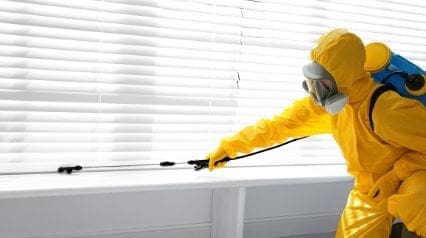Welcome to our blog post on pest-proofing your home! While many homeowners focus solely on installing alarms and security systems, it’s important not to overlook another potential threat lurking in the shadows – pests. Whether it’s pesky insects or sneaky rodents, these unwanted house guests can cause damage to your property and pose health risks to you and your family. That’s why taking proactive measures to pest-proof your home is crucial. In this article, we will guide you through the steps of keeping pests at bay both indoors and outdoors. So, let’s dive in and make sure your home remains a fortress against all intruders, big or small!
Why Pest-Proof Your Home?
Pests in the home can be more than just a nuisance. They can cause extensive damage to your property, contaminate food and surfaces, and even spread diseases. By pest-proofing your home, you are taking proactive measures to prevent these issues from occurring.
Pest infestations can lead to costly repairs. Termites, for example, can cause significant structural damage that may require expensive renovations. Additionally, rodents like rats and mice have been known to chew through electrical wires and insulation, posing fire hazards.
Pests carry bacteria and pathogens that can contaminate surfaces and food sources in your home. Cockroaches are notorious carriers of disease-causing germs such as Salmonella and E.coli. By implementing effective pest-proofing methods, you reduce the risk of exposure to these harmful microorganisms.
How to Pest Proof Your Home?
One of the most effective ways to keep pests out of your home is by pest-proofing it. By taking preventative measures, you can minimize the risk of infestation and ensure a safe living environment for you and your family. Here are some simple steps to follow in order to pest-proof your home.
First, start by sealing off any entry points that pests could use to gain access to your home. This includes checking for gaps or cracks in doors, windows, and walls. Use caulk or weatherstripping to seal these openings and prevent pests from entering.
Next, make sure to keep your home clean and clutter-free. Pests are attracted to food sources, so be diligent about cleaning up spills and crumbs promptly. Store food properly in sealed containers to deter pests from getting into them.
Consider using natural pest deterrents such as essential oils or vinegar sprays. These can help repel insects without relying on harmful chemicals. Additionally, regularly inspecting your home for signs of potential infestation can help catch any issues early on before they become major problems.
By following these simple tips, you can effectively pest-proof your home and create a more secure living space for yourself and your loved ones.
Pest-Proofing for Indoor Areas
When it comes to pest-proofing your home, don’t forget about the importance of protecting your indoor areas. Pests can easily find their way into your living spaces, causing damage and spreading diseases if left unchecked. By taking a few simple measures, you can minimize the risk of unwelcome critters invading your home.
Pay attention to protecting electrical wires and appliances. Rodents are notorious for chewing on wires, which can lead to electrical failures or even fires. To prevent this, make sure all openings around pipes and cables are sealed off securely with materials such as steel wool or caulk.
Next, focus on sealing gaps and cracks in walls and floors that may serve as entry points for pests like ants or cockroaches. Use weatherstripping along doors and windows to prevent bugs from slipping through tiny crevices. Don’t forget about checking vents and ducts, too – these should be properly screened to keep pests out while allowing proper ventilation.
By implementing these indoor pest-proofing tips along with outdoor precautions (which we’ll discuss next), you’ll create an environment that is less appealing for pests looking for shelter or sustenance in your home!
Protecting Electrical Wires and Appliances
Safeguarding your electrical wires and appliances is an important aspect of pest-proofing your home. Rodents, such as mice and rats, can cause significant damage by chewing on these essential components. Not only does this pose a fire hazard, but it also disrupts the functioning of your electronic devices.
To prevent rodents from accessing electrical wires, seal any existing gaps or cracks around outlets, switches, and wiring conduits with caulk or wire mesh. Additionally, consider using rodent-repellent insulation to protect exposed wires in attics or crawl spaces.
By taking these simple measures to safeguard your electrical wires and appliances from pests’ destructive habits, you can ensure the safety of both your home and its inhabitants while maintaining the longevity of your valuable electronic equipment.
Pest-Proofing for Outdoor Areas
When it comes to pest-proofing your garden and backyard areas, pests can easily make their way into your home through cracks in the foundation or gaps around doors and windows. Here are a few tips to help you keep those unwanted pests at bay:
- Seal any cracks or crevices: Inspect the exterior of your home for any gaps or cracks that could serve as entry points for pests. Use caulk or weatherstripping to seal them up and prevent easy access.
- Trim vegetation away from your house: Overgrown bushes and trees can provide a convenient bridge for insects and rodents to enter your home. Keep plants trimmed back and maintain a clear perimeter around your house.
- Store firewood properly: If you have firewood stored near your house, make sure it is elevated off the ground and kept at least 20 feet away from the exterior walls. This helps deter termites and other wood-damaging pests from making their way into your home.
- Clean up debris: Remove piles of leaves, grass clippings, mulch, or other debris from around the foundation of your home. These materials provide hiding places for pests like ants and cockroaches.
- Install screens on vents: Make sure all external vents leading into crawl spaces or attics are equipped with sturdy screens to prevent wildlife, such as squirrels or birds, from entering these areas.
Remember that pest-proofing is not a one-time task; it requires ongoing maintenance to ensure long-term effectiveness. Stay vigilant in monitoring potential entry points, maintaining cleanliness both inside and outside of your property, and promptly addressing any signs of an infestation should they arise.
With these steps in place, you’ll be well on your way to creating a pest-free sanctuary that you and your family can enjoy all year.

